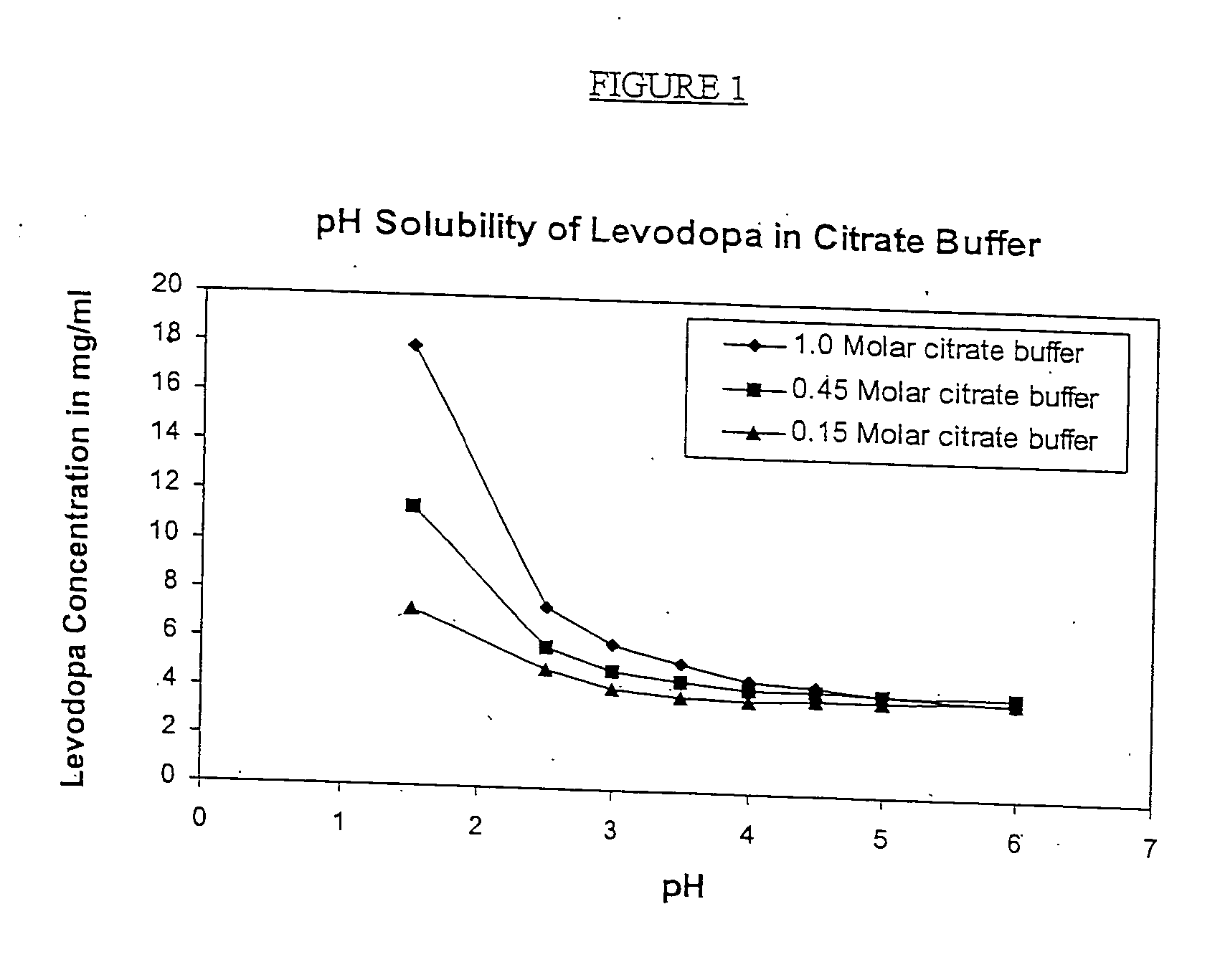Pharmaceutical compositions and method of using levodopa and carbidopa
a technology of levodopa and composition, which is applied in the direction of drug composition, dispersed delivery, peptide/protein ingredients, etc., can solve the problems of poor balance and walking, tremor, and inability to make breakfast or coffee, and can be difficult for parkinson's disease patients to make simple movements
- Summary
- Abstract
- Description
- Claims
- Application Information
AI Technical Summary
Benefits of technology
Problems solved by technology
Method used
Image
Examples
example 1
Solubility of Levodopa in Citrate Buffer at Varying pH and Buffer Strength
Solutions were made using Citric acid and tribasic Sodium Citrate dihydrate Initially a 1.0 M citric acid solution was made by weighing out 19.2 g Citric acid (FW 192.1) into a 100 mL volumetric flask and diluting with HPLC grade water. This was repeated with the Sodium Citrate (FW 294.1), by weighting out 29.4 g of sodium citrate in into a 100 mL volumetric flask and diluting to 100 mL with water. A series of 8 of 20 mL scintillation vials were then labeled and prepared as follows:
For 1.0 molar samples of pH 1.5 (pure citric+HCl), 2.5, 3.0, 3.5, 4.0, 4.5, 5.0, 6.0 were made. These pH adjustments were made with the sodium citrate (also 1.0 M) to keep a consistent molarity with the citrate. From these mother vials, 2 subsequent sets of solution were made for the molar concentrations 0.45 and 0.15 M. 0.45 M is for a 3:1 buffer and 0.15 M is for a 1:1 buffer. These solutions were also pH a...
example 2
Stability of Levodopa and Carbidopa
A formulation of: Levodopa / Citric acid / Carbidopa / Sucrose mix at molar ratio of 1:3:0.2:1. This powder mixture was dissolved in water at a concentration of 5.5 mg / ml of levodopa. This solution was filter through a 0.22 micrometer filter (with PVDF membrane) and then stored at temperatures of 4 degrees C., 25 degrees C. and 40 degrees C.
A formulation of Levodopa / Ascorbic acid / Carbidopa mix at molar ratio of 1:3:0.25. This powder mixture was dissolved in water at concentration of 1.0 mg / ml of levodopa. This solution was filtered through a 0.22 micrometer filter (with PVDF membrane) and then stored at temperatures of 4 degrees C., 25 degrees C. and 40 degrees C.
The sample solutions were submitted for HPLC potency test at each time point. The stability was monitored in percentage change compared to the initial potency.
Sample nameCompoundInitial1 Day2 Day3 Day7 DayLevodopa / Citric / Levodopa100%100%100% 100% 100%Carbidopa / Sucros...
example 3
Carbidopa Degradent
Samples of levodopa / carbidopa / citric acid and levodopa / carbidopa / ascorbic acid at a molar ratio of 4:1:1 were made. Samples were kept at 25 degrees Celsius for 24 hours. After 24 hours, samples were assayed on an HPLC. Analysis was carried out on Waters Alliance HPLC system equipped with 2695 separation module and 2996 PDA detector. Reversed phase HPLC method was utilizing Waters Atlantis dC18 column (4.6×150 mm, 5 um) operated at 30 C and a two component gradient mobile phase. Run time was 30 min at flow rate 1.0 mL / min. Levodopa and carbidopa impurities and degradation products were detected by absorbance at 280 nm and reported as their percent area relative to the parent peak. A new peak was determined to be 3,4-dihydroxyphenylacetone by HPLC / MS. 3,4-dihydroxyphenylacetone (DHPA) is a carbidopa degradent. This degradent is also present in formulations of levodopa / carbidopa / orange juice and in formulations of levodopa / carbidopa / ginger ale.
PUM
| Property | Measurement | Unit |
|---|---|---|
| concentration | aaaaa | aaaaa |
| concentration | aaaaa | aaaaa |
| concentration | aaaaa | aaaaa |
Abstract
Description
Claims
Application Information
 Login to View More
Login to View More - R&D
- Intellectual Property
- Life Sciences
- Materials
- Tech Scout
- Unparalleled Data Quality
- Higher Quality Content
- 60% Fewer Hallucinations
Browse by: Latest US Patents, China's latest patents, Technical Efficacy Thesaurus, Application Domain, Technology Topic, Popular Technical Reports.
© 2025 PatSnap. All rights reserved.Legal|Privacy policy|Modern Slavery Act Transparency Statement|Sitemap|About US| Contact US: help@patsnap.com


